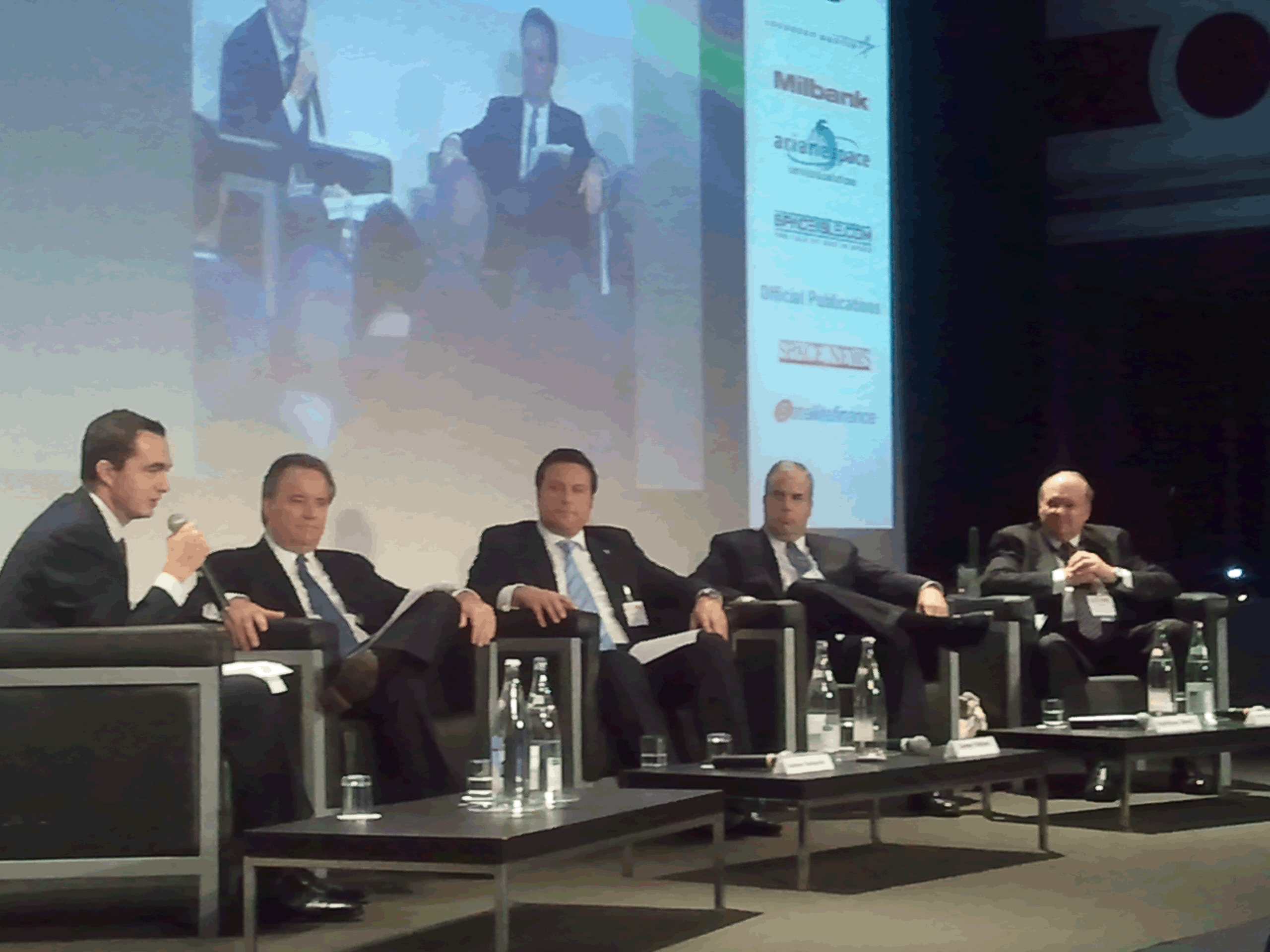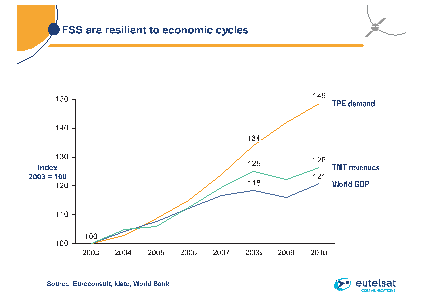Industry Outlook Generally Positive at Satellite Business Week 2011

by Elisabeth Tweedie, Associate Editor
Paris, September 26, 2011-- Although the overall mood at the Satellite Business Week conference in Paris organized by Euroconsult was not as ebullient as it has been in the last couple of years it was none the less generally positive.
The first day was marked by a lively discussion between Euroconsult and the satellite manufacturers as to the likely number of satellite orders in the next few years. Euroconsult’s forecast indicating that we are now at the peak of a cycle with a three year average of 26 orders per annum valued at US$4.5B in the 2011-13 timeframe, but that this was going to fall to an average of 17 per annum by 2016-18 valued at only US$2B. Kathy Shockey, VP of Business Development, Space Systems Loral opened her presentation by commenting that if she believed those numbers she would be on her way to Notre Dame to light a candle for the industry! Her analysis of the market indicated that although the market may fall a little it would not be as drastic a downturn as Euroconsult predicted. Of the 290 communication satellites in orbit, 190 were due to be replaced in the next few years. Jean-François Charrier, VP Marketing and Institutional Relations EADS Astrium agreed saying that he was expecting an average of 22 orders p.a. in the coming years.
It’s been noted before at Satellite Business Week; the satellite industry has suffered less from the global economic downturn than other industires. Eutelsat presented a chart clearly demonstrating this, showing that growth in TPE demand continued to outpace growth in both world GDP and Telecom, Media and Technology (TMT) revenues. Maybe this is one reason why export credit financing is still flowing. The satellite industry has benefited from $4.5B of this since 2009 and an additional $3B has been announced or is in the pipeline.
 On the application front the things that generated most discussion were Ka-Band and video, OTT in particular.
On the application front the things that generated most discussion were Ka-Band and video, OTT in particular.
One thing everyone was agreed on was that Ka-Band is becoming a major force in the industry. No one making this point more succinctly than Tom Moore, Senior VP of ViaSat who produced a chart showing that Ka-Band was generating revenue of $500K per annum per licensed MHz – an order of magnitude higher than revenue from Ku-Band. He also pointed out that he combined Ka-Band retail service revenues of HNS and ViaSat ranked on a par with the revenue of JSAT, the fourth largest FSS Operator in the world.
With only one HTS recently launched it is not surprising that Euroconsult indicate that of the approximately 1,600 enterprise broadband terminals currently in use only a very few are pointed at High Throughput Satellites (HTS). However by 2020 the picture will be very different with over 50% of the approximately 4.3M enterprise terminals pointing in their direction. On the consumer side the growth in Ka-Band subscribers is even more dramatic; predicted to increase from around 1.5M today, to around 14M by 2020. Combine these projections with Tom Moore’s data and it’s easy to understand why the future is Ka!
With a KA-SAT service launch on May 31st of this year Andrew Wallace, Chief Commercial Officer of Eutelsat was keen to point out that Eutelsat was operating the world’s largest HTS. However since ViaSat 1 is now at Baikanour awaiting a launch, all being well this will be a short lived claim. He opened his presentation by stating that in Europe the market for satellite broadband existed in all countries. 13M households only have dial-up service and another 17M have “broadband” of less than 2Mbps. He cited the case of a village in the UK only 75 minutes by car from a major city, which had no terrestrial broadband service at all. KA-SAT is offering 50Mbps down and 20Mbps up for enterprise customers and 10/4Mbps for consumers. For Eutelsat KA-SAT is being marketed to exisiting Ku broadcast customers as a means to offering triple play. Forthnet in Greece is now offering this service. Other speakers pointed out that the reverse is occurring and DTH is being marketed by Telcos as their means of providing triple play.
Ka-Band is being used for applications beyond the basic consumer and enterprise broadband, one of the most interesting being its entry into the SNG market. A Ku-Band SNG terminal costs around €150,000 and has to be mounted on a truck. A Ka-Band SNG terminal can be packed in a suitcase for rapid transport to anywhere in the world that news crews jet into and costs only €10,000. As more Ka-Band satellites are deployed the relay of news from remote areas could change significantly. Other potential applications include mobile (maritime, aeronautical and terrestrial), military, local TV and off-shore.
David Williams, CEO of Avanti said that Hylas was being used for 4 main applications. In addition to consumer and enterprise broadband it was also serving Government Organizations (Institutions and Military) and providing backhaul and edgecasting for Mobile Operators. He said that he didn’t expect consumer broadband ever to represent more than 25% of capacity, primarily because consumer applications ramp up relatively slowly compared to other applications that ramp up in large “chunks”.
Tom Moore predicted that there would be another 12 serious Ka-Band programs on the books in the next year, something that should please but not surprise the manufacturers. Charrier pointing out that eight out of the fourteen satellites currently on the order books had Ka-Band payloads and Shockey predicting that 20% of orders in the next five years would be for broadband satellites. All the operators agreed that the market was deriving considerable benefit from government funding around the world to extend the reach of broadband.
Bahram Pourmand, President of Hughes USA commented that the Echostar purchase of Hughes was giving them a stronger reach into the market, mentioning that Hughes had global ambitions for Spaceway and was currently working with Avanti and YahSat and hoped to expand on those relationships. Jupiter – Hughes’ HTS - is due to be launched in the first quarter of 2012.
Video has been and continues to be a key driver for the satellite market, what is changing is the impact of HD which is now fueling the growth as the increase in new SD channels is slowing. Excluding DIRECTV and Dish there are now 1,600 HD channels worldwide (approximately 500 of these are in North America). Most of the growth has come from countries outside of North America, with the number of HD channels virtually doubling in the last year from 560 to 1,100. Overall the video distribution market has shown a CAGR of 13% for the last few years. Of the 126 DTH platforms in service in 2010, 80 were offering HD services. 3D channels are making their appearance but Euroconsult forecasts show them representing only a small sliver of the market by 2020.
At the end of 2010 there were 29,000 satellite TV channels – 2,000 more than at the end of the previous year and this is predicted to increase to 45,000 by 2020. Emerging markets continue to fuel this growth accounting for 90% of the net increase for the last two years.
The impact of Over The Top (OTT) TV was acknowledged but its impact debated. Most saying that while it is definitely a factor to be considered demand for cable and satellite delivery would remain the dominant force. David Hershberg, CEO of Globecomm had a very different viewpoint stating very forcibly that DTH was going away and would be replaced by broadband in the next 10 years. If he is correct – and his predictions have been so before – this industry will be very different in 2021.
-----------------------------------------------
 Elisabeth Tweedie is Associate Editor for Satellite Markets and Research. She has over 20 years experience at the cutting edge of new communication and entertainment technologies. She is also the founder and President of Definitive Direction, a consultancy that focuses on researching and evaluating the long term potential for new ventures, initiating their development and identifying and developing appropriate alliances. During her 10 years at Hughes Electronics she worked on every acquisition and new business that the company considered during her time there. She can be reached at: elisabeth@satellitemarkets.com
Elisabeth Tweedie is Associate Editor for Satellite Markets and Research. She has over 20 years experience at the cutting edge of new communication and entertainment technologies. She is also the founder and President of Definitive Direction, a consultancy that focuses on researching and evaluating the long term potential for new ventures, initiating their development and identifying and developing appropriate alliances. During her 10 years at Hughes Electronics she worked on every acquisition and new business that the company considered during her time there. She can be reached at: elisabeth@satellitemarkets.com





